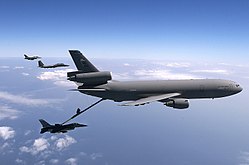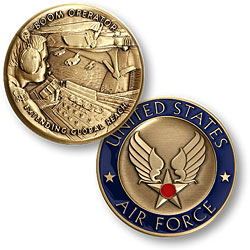| USAF Boom Operator | |
|---|---|
 | |
| Active | September 16, 1948 [1] [2] – present (77 years, 1 month) |
| Country | |
| Branch | |
| Type | In-flight refueling specialist [3] |
| Role | Aerial refueling (U.S. & allies) Airlift (cargo & personnel) Special operations Nuclear operations [1] [3] [4] [5] |
| Size | 765 (90% male, 10% female) [6] |
| Garrison/HQ | List of Air Refueling Squadrons |
| Nicknames | "Boom", "Boomer" [4] [7] |
| Motto | "Nobody Kicks ASS Without Tanker Gas!" (NKAWTG) [8] |
| Engagements | |


In the U.S. Air Force (USAF), a boom operator is an aircrew member aboard tanker aircraft who is responsible for safely and effectively transferring aviation fuel from one military aircraft to another during flight (known as aerial refueling , air refueling, in-flight refueling, air-to-air refueling, and tanking). The name boom operator implies that one "operates a boom" (the flying boom ), which is a long, extendable metal arm attached to the rear underside of the tanker that the boom operator connects to the fuel receptacle of a receiving aircraft (the receiver). The boom operator also controls the refueling drogue, a basket attached to a flexible hose that trails the tanker, when using the probe-and-drogue system. [1] [9] [10] [11] The USAF officially designates the boom operator career field as "In-Flight Refueling" with a specialty code of 1A0X1. However, this designation is usually reserved for administrative paperwork such as enlistment contracts and performance reports, as boom operators themselves are rarely referred to as in-flight refueling specialists within the USAF. The title "Boom Operator" is most commonly used, in reference to the aircrew position they occupy on the airplane, as noted in USAF regulations and aircraft flight manuals. [3] [12] [13] Fellow crew members affectionately address them as "boom" or "boomer" [4] [7] (though the use of the term "boom" in this article refers to the flying boom, not the boom operator).
Contents
The boom operator crew position was created in 1948 when Boeing developed the flying boom at the request of the USAF. Prior to this, when the only practical means of transferring fuel was through a hose, other crew members fulfilled the duty of operating the air refueling equipment, such as the hose reel operator in the DH-4B and C-1 and the line operator in the B-24D and KB-29M using the grappled-line looped hose system. [1] [9] In the modern U.S. military, the boom operator crew position only exists in USAF tankers equipped with a flying boom, such as the KC-135, KC-10, and the newly developed KC-46. For tanker aircraft not equipped with a flying boom, such as the KC-130, HC-130, and F/A-18E/F, the specific crew member(s) responsible for operating the air refueling equipment and supervising refueling operations varies by aircraft. Boom-equipped tankers have been obtained by several foreign countries as a result of USAF tanker procurement programs and U.S. foreign military sales. An estimated 63 boom-equipped tankers (KC-135, [14] [15] [16] KC-10, [17] A330 MRTT, [18] [19] KC-767, [20] [21] [22] [23] and KC-33 [24] ) are operated by 14 foreign countries; in comparison, the USAF operates 457 KC-135 and KC-10 tankers. [10] [11] [25] [26]









